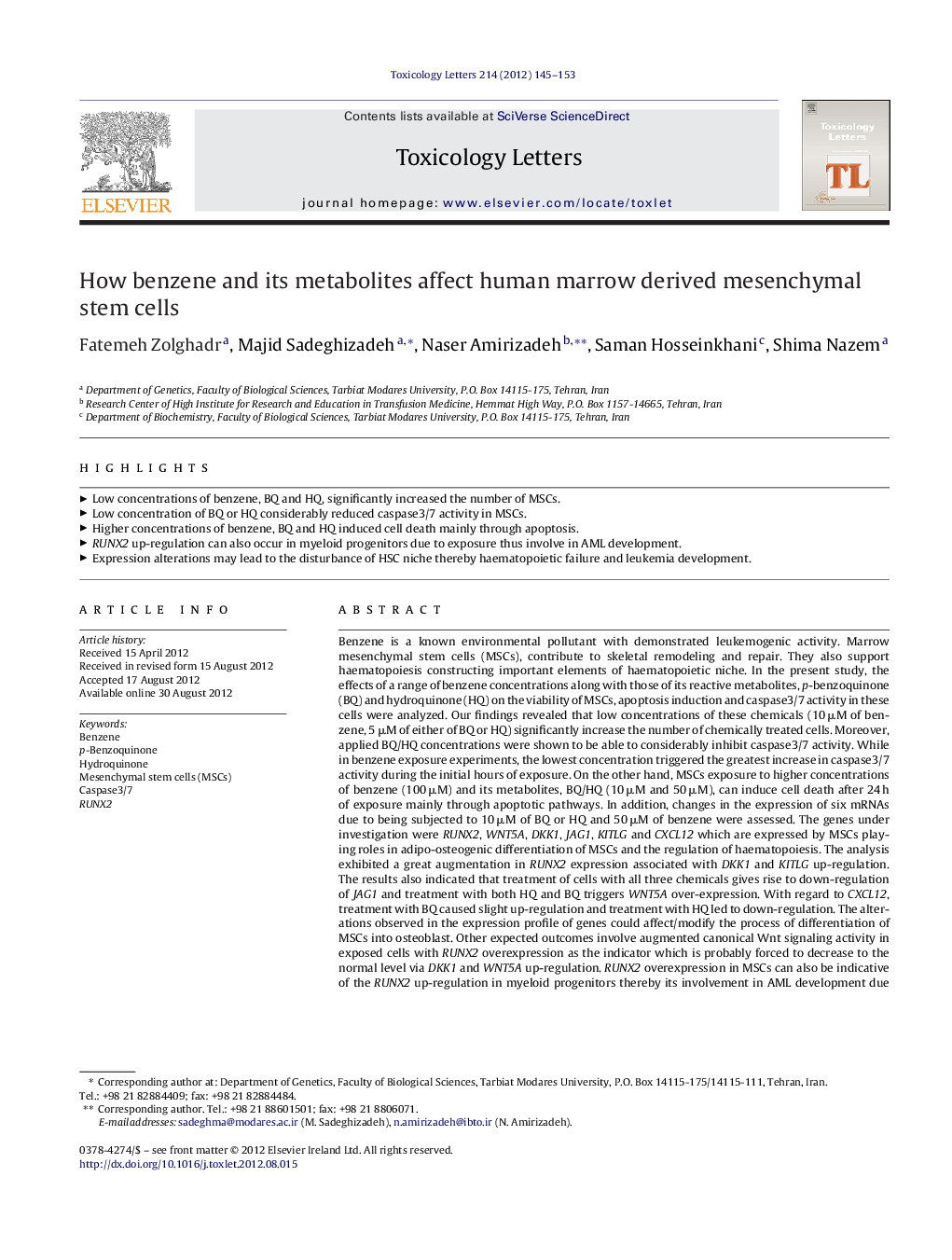| کد مقاله | کد نشریه | سال انتشار | مقاله انگلیسی | نسخه تمام متن |
|---|---|---|---|---|
| 2599637 | 1133223 | 2012 | 9 صفحه PDF | دانلود رایگان |

Benzene is a known environmental pollutant with demonstrated leukemogenic activity. Marrow mesenchymal stem cells (MSCs), contribute to skeletal remodeling and repair. They also support haematopoiesis constructing important elements of haematopoietic niche. In the present study, the effects of a range of benzene concentrations along with those of its reactive metabolites, p-benzoquinone (BQ) and hydroquinone (HQ) on the viability of MSCs, apoptosis induction and caspase3/7 activity in these cells were analyzed. Our findings revealed that low concentrations of these chemicals (10 μM of benzene, 5 μM of either of BQ or HQ) significantly increase the number of chemically treated cells. Moreover, applied BQ/HQ concentrations were shown to be able to considerably inhibit caspase3/7 activity. While in benzene exposure experiments, the lowest concentration triggered the greatest increase in caspase3/7 activity during the initial hours of exposure. On the other hand, MSCs exposure to higher concentrations of benzene (100 μM) and its metabolites, BQ/HQ (10 μM and 50 μM), can induce cell death after 24 h of exposure mainly through apoptotic pathways. In addition, changes in the expression of six mRNAs due to being subjected to 10 μM of BQ or HQ and 50 μM of benzene were assessed. The genes under investigation were RUNX2, WNT5A, DKK1, JAG1, KITLG and CXCL12 which are expressed by MSCs playing roles in adipo-osteogenic differentiation of MSCs and the regulation of haematopoiesis. The analysis exhibited a great augmentation in RUNX2 expression associated with DKK1 and KITLG up-regulation. The results also indicated that treatment of cells with all three chemicals gives rise to down-regulation of JAG1 and treatment with both HQ and BQ triggers WNT5A over-expression. With regard to CXCL12, treatment with BQ caused slight up-regulation and treatment with HQ led to down-regulation. The alterations observed in the expression profile of genes could affect/modify the process of differentiation of MSCs into osteoblast. Other expected outcomes involve augmented canonical Wnt signaling activity in exposed cells with RUNX2 overexpression as the indicator which is probably forced to decrease to the normal level via DKK1 and WNT5A up-regulation. RUNX2 overexpression in MSCs can also be indicative of the RUNX2 up-regulation in myeloid progenitors thereby its involvement in AML development due to benzene exposure. Observed changes in the expression of WNT5A, DKK1, KITLG, CXCL12 and JAG1 can lead to the disturbance of HSC niche resulting in haematopoietic failure and leukemia development. It is obvious that increased viability together with caspase3/7 inhibition could aggravate the adverse effects of exposure to these chemicals.
► Low concentrations of benzene, BQ and HQ, significantly increased the number of MSCs.
► Low concentration of BQ or HQ considerably reduced caspase3/7 activity in MSCs.
► Higher concentrations of benzene, BQ and HQ induced cell death mainly through apoptosis.
► RUNX2 up-regulation can also occur in myeloid progenitors due to exposure thus involve in AML development.
► Expression alterations may lead to the disturbance of HSC niche thereby haematopoietic failure and leukemia development.
Journal: Toxicology Letters - Volume 214, Issue 2, 17 October 2012, Pages 145–153